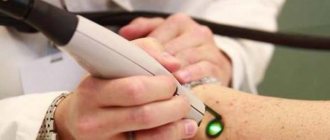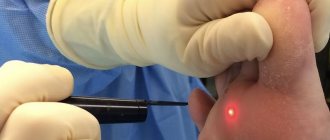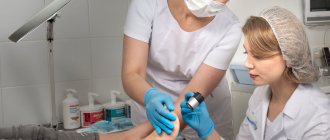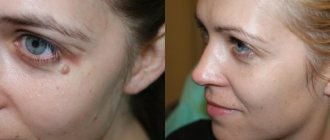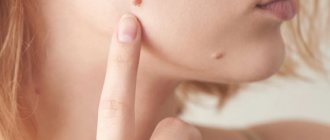An incomprehensible spot appeared on the skin.
Then one more thing.
Soon, a whole demonstration of unknown neoplasms is built on the face, hands or other areas.
These are usually flat warts.
Such formations are small, smooth growths with a diameter of up to three millimeters. They are almost invisible and rarely hurt.
Doctors call them juvenile warts because the growths primarily affect children and adolescents.
There are always a lot of growths. Typically, from 20 to 200 formations appear, which are grouped in one area. A single wart is almost no different from the skin. A large group of neoplasms stand out much more and often become a cosmetic problem.
Why do they grow?
Due to the human papillomavirus or HPV. Scientists have identified over 100 types of the disease, and flat warts are caused by types 3, 18, 28 and 49. These types of the virus are benign, unlike other types that increase the risk of developing cancer of the uterus and genital organs.
The likelihood of growths increases:
- Direct contact with wart carriers
- Scratches and other damage
- Touching a contaminated object
- Poor hygiene
- Weakened immunity due to illness or treatment
In most cases, a colony of warts surrounds scratches and wounds. Often the virus enters the body through damage, so that neoplasms grow in the neighborhood.
Non-genital types of HPV affect up to 10% of the world's population. Most of them are teenagers 12-16 years old. It’s not for nothing that these growths are called juvenile warts, because children are more likely to become infected and spread the human papillomavirus.
Their tumors grow on different parts of the body.
Types of warts
Viral warts in children are classified into common, flat and plantar. Each species has distinctive characteristics and location. In children, ordinary formations are most often observed - small formations (up to several mm in diameter), rising above the surface of the skin. They have a rough, rough surface, sometimes with villi included in their structure. Common warts are flesh-colored. A single neoplasm or a group of warts merging with each other may be observed. The child may not experience any unpleasant symptoms - pain, itching and discomfort are not normally observed.
Plantar lumps can cause discomfort. This is why the need for quick treatment of warts on a child’s foot arises more often - the formations can cause pain while walking.
Flat ones often form on the back of the hand, forearms, face, and mucous membranes. They are multiple flesh-colored formations.
It is important to understand that such formations in most cases disappear on their own within 6 months. If formations persist for more than 2 years, we are talking about a persistently current condition. This is explained by the life cycle of the virus - up to two years, and the persistence of the wart indicates its active reproduction; the little patient’s immunity cannot cope with suppressing the infection.
Types of flat warts
All juvenile warts are almost the same. They are flesh-colored or brown in color and are only slightly raised above the skin. Therefore, they are difficult to detect.
Based on location, growths are divided into:
- Flat plantar warts
- Flat warts on the face
- Flat warts on the body
The greatest problems are caused by neoplasms on the face. Yes, flesh-colored growths, even in large quantities, are almost invisible, but with a different color they stand out on the skin. Mostly, patients want to remove warts on the face.
The formations on the legs and arms are not so obvious. At the same time, growths on your hands increase the risk of infection to people you come into contact with.
Should they be removed?
Hard to tell. These warts are completely safe and never turn into malignant tumors. Yes, they are contagious. But there is no threat to health or life.
Symptoms
A flat wart appears as a small papule up to 5 mm, slightly rising above the epidermis. The nodule can be either round or irregular in shape. It is smooth to the touch, with clearly defined boundaries. During the rash period, several elements appear, separated from each other. Neoplasias do not tend to merge. In the wart area, the skin is smooth and shiny, without cracks, keratinization, or growths.
A characteristic feature is the absence of a skin pattern and itching on the surface of the formation. The color of the papule matches the shade of healthy skin, sometimes it can change to light beige or pale pink. Most often, flat formations appear on the neck, face, back of the hands, and the outer area of the feet. This localization is associated with increased trauma to these areas of the body. There are a large number of sebaceous glands on the face, which often become clogged and inflamed, which also makes this area a risk area. Juvenile neoplasms never affect the soles and palms.
The main danger of flat warts is their injury and inflammation. Constant irritation of neoplasia opens the gates for infection and increases the risk of cell degeneration.
Why do flat warts appear?
We have already talked about this. Such neoplasms arise due to the human papillomavirus.
HPV enters the body. Mostly through scratches or cuts, but maybe through undamaged skin. The virus affects skin cells and they mutate - they grow larger than usual and form warts.
HPV is not only transmitted from person to person. It also spreads within the same body. For example, a teenager touches and scratches growths on his face, and then touches his neck with his fingers. Now a source of infection may arise there too.
Or another example: flat warts appeared on the fingers. The man wiped his hands with a towel, and after a short time he also wiped his face - this is how the virus spread from his fingers to his cheeks or forehead.
Remember the reason for the appearance of flat warts. This will help you effectively treat tumors and prevent their return.
Warts in children: causes, symptoms, treatment
General information
Warts are benign formations on the skin or mucous membranes that arise as a result of infection with papillomavirus. Warts typically occur in children or teenagers with weakened immune systems. The formations have different appearances, depending on the location and age of the child.
Causes of warts
Warts are the result of infection with the human papillomavirus (HPV). This is one of the most common viruses in the world, with more than 100 strains. Some strains lead to the appearance of warts. It is quite simple to become infected with the virus - it enters the body from the carrier through microtraumas, abrasions, and diaper rash. The virus may not manifest itself immediately after infection; it can live in the body asymptomatically for some time. This period can last up to six months. After this, the virus begins to multiply in the body.
A child can become infected with HPV in public places (playgrounds, public transport, swimming pool), in contact with other people, as well as through household items. In addition, the virus can be transmitted to the child by the mother during pregnancy.
It is worth noting that children will not always develop warts if they are infected with HPV. As a rule, they occur with weakened immunity and in combination with a number of other factors:
- stress;
- sedentary lifestyle;
- failure to comply with personal hygiene rules;
- avitaminosis;
- unbalanced diet;
- uncomfortable shoes (in case of plantar warts);
- hormonal changes;
- chronic diseases;
- frequent colds.
Types and symptoms of warts
There are different types of warts, which determines their location on the child’s body.
Types of warts:
- ordinary, or vulgar;
- plantar, or spines;
- youthful, or flat;
- acrochords, or filamentous;
- genital or condylomas.
Let's look at each of these types in more detail.
Regular
warts are the most common. They have a round appearance, similar to a ball, rising above the skin, rough to the touch. As a rule, they appear on the arms, legs, back, and knees. Hair growth may be observed in the central part of the wart. Such formations do not itch and do not cause any discomfort. If there are several such warts on the body, then among them one can distinguish one large “mother” and several smaller ones. The color of warts vulgaris is usually flesh-colored to light brown.
Plantar
usually localized on the foot under the big toe. Outwardly, they resemble dark gray calluses, have a rounded appearance, a dense structure and a deep root. These warts may hurt while walking.
Youth
warts rise slightly above the skin and are without a stalk, have an irregular shape and a flat, smooth surface. May be pigmented. Such warts appear in children over 5 years of age, on the neck, face, hands and legs. A characteristic feature of such formations is several growths in one area of the body.
Acrochords
appear in places near the mucous membrane on the face near the eyes, nose, mouth, and can also appear in the armpits. They do not differ in color from the surrounding skin, but have an elongated shape and are capable of growing quickly. Such warts can be injured very easily and often cause discomfort.
Condylomas
appear on thin skin, mucous membranes and genitals. Genital warts have a pink papillary structure and consist of multiple neoplasms.
Usually there are no other symptoms other than visual detection. To detect warts on a child's body, you need to regularly examine his body while bathing or changing clothes.
Treatment of warts in children
The appearance of warts on a child’s body is a reason to contact a pediatric dermatologist. Such formations do not go away on their own, and treatment consists of removing them. It is worth noting that removing a wart does not eliminate the cause of its appearance, since there is no cure for the human papillomavirus.
Nowadays, there are several methods for removing warts.
- cryodestruction;
- electrocoagulation (removal using electric current);
- laser removal;
- surgical removal.
Cryodestruction method
consists of cauterizing the wart with liquid nitrogen. Removal occurs in several procedures (up to four). This method is recommended for older children.
With electrocoagulation
warts are killed by electric current. On the 2-3rd day after removal, a crust forms at the site of the wart, which falls off on the 5-7th day after the procedure. The manipulation is carried out under local anesthesia. This removal method is not suitable for plantar warts.
Advantages of the laser method
removal is that it does not cause complications and does not leave scars. This method eliminates the possibility of infection. The manipulation takes a few minutes and is performed under local anesthesia.
Surgical method
consists of excision of the formation with a scalpel. The procedure takes place under local anesthesia. The wound that results from the procedure takes up to two weeks to heal and often leaves a scar. This removal method is usually not used for young children.
Prevention of warts
An important part of prevention is HPV vaccination. There are two vaccines that can protect against several strains of the virus - Cervarix and Gardasil. The first protects against strains 16 and 18, and the second protects against strains 6, 11, 16 and 18. By protecting your child from HPV infection, you minimize the risk of certain types of warts.
In addition, prevention of the appearance of formations consists of observing the rules of personal hygiene, good nutrition, and physical activity.
Teach your child to always wash their hands after walking and before eating. Provide your baby with a varied diet, which should include fruits and vegetables, fish, meat, and dairy products. This way you will provide your child with a complete set of vitamins and microelements.
Sports and walks in the fresh air will help strengthen your baby's immunity.
When should you see a doctor for flat warts?
In any case, we recommend making an appointment with a dermatologist. Yes, it is easy to diagnose growths. Flat warts have characteristic features and you can easily determine the type of tumor. However, there are also difficult cases.
Sometimes the growths don't look like typical flat warts. In such situations, you cannot do without the help of a doctor, because a dermatologist has a much better understanding of neoplasms. He can also perform a dermatoscopy. This is the name of the study of formation using a special apparatus - a dermatoscope.
So, the doctor helps with the diagnosis.
What about treating warts?
It is not necessary - in most patients the formations disappear on their own. Yes, not right away. Scientists conducted a study on this topic and found out the approximate lifespan of flat tumors. Up to 23% of warts disappear within two months. Up to 73% in two years. That is, in a couple of years, most of the formations will disappear.
When should flat warts be removed?
Treatment will be required if the growths:
- Bleeding
- Grow
- Change color
These are alarming signs in which it is best to go for an examination with a dermatologist. The doctor will determine the degree of danger of the formations. Sometimes they need to be removed. Usually no.
So operations are often performed at the request of patients, and not due to medical necessity.
Treatment
Juvenile warts have a tendency to disappear on their own when the patient’s condition is stabilized and the immune system is strengthened. Sometimes this takes a lot of time, and an aesthetic defect forces one to resort to radical methods to get rid of the problem. The main criterion when choosing a method is to guarantee safety, effectiveness and absence of scars.
Taking into account the requests of patients, the optimal solution is radio wave treatment with the Surgitron device. The wave penetrates only to the depth necessary to remove formations. At the same time, coagulation of blood vessels occurs, which minimizes blood loss. The duration of the procedure is 15-20 minutes. During this time, the doctor manages to remove several flat warts at once.
To prevent new growths, it is recommended to undergo a course of antiviral and immunomodulatory therapy. This allows you to achieve stable remission and put the virus into a dormant state.
Treatment of flat warts
Although these tumors disappear sooner or later, not all people are ready to wait for months for a joyful moment. They want to speed up this process.
For example, with the help of improvised means, salicylic acid is very popular, which gradually destroys the tissue of warts.
Unfortunately, this method has not been properly studied at this time. No studies have been conducted.
Doctors do not recommend using salicylic acid, as it can leave scars and burns on the skin. To treat flat warts, it is better to use proven methods. One option is for dermatologists to prescribe special creams that irritate the upper layer of growths. After treatment, the tumor is simply torn off.
Creams are not always effective. Sometimes get rid of flat warts only by surgical methods.
How to remove flat warts
Now doctors remove tumors using different methods.
It is important to note that in rare cases, new growths appear after surgery. Therefore, be sure to consult a dermatologist about treatment and its possible consequences.
Procedures for removing flat warts:
- Surgical excision
Previously, this method was widespread, but now patients often choose more technological methods. The doctor cuts out the wart with a scalpel. It also removes the thin layer of skin around the tumor, which prevents the tumor from returning. A wound remains at the site of the wart. As it heals, a scar appears.
- Cryotherapy
The dermatologist freezes the growth with liquid nitrogen. The wart gradually dies and falls off - a wound forms in its place, which heals in a few weeks.
- Laser therapy
The doctor burns out the tumor. The tissues of the formation are completely destroyed, and the adjacent vessels are baked. The wound is covered with a protective crust and heals in three weeks.
The choice of appropriate therapy depends on the location of the flat warts, as there is a risk of scarring. The size of the formation and the health of the patient affect the rate of healing.
Do not schedule surgery without consulting a dermatologist. He will tell you how to remove flat warts and how to maintain healthy skin, without scars and scars.
Laser therapy is very popular. Many people prefer to eliminate tumors using this method.
Why?
Laser surgery is simply superior to other procedures in some respects.


